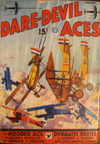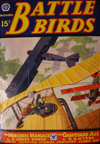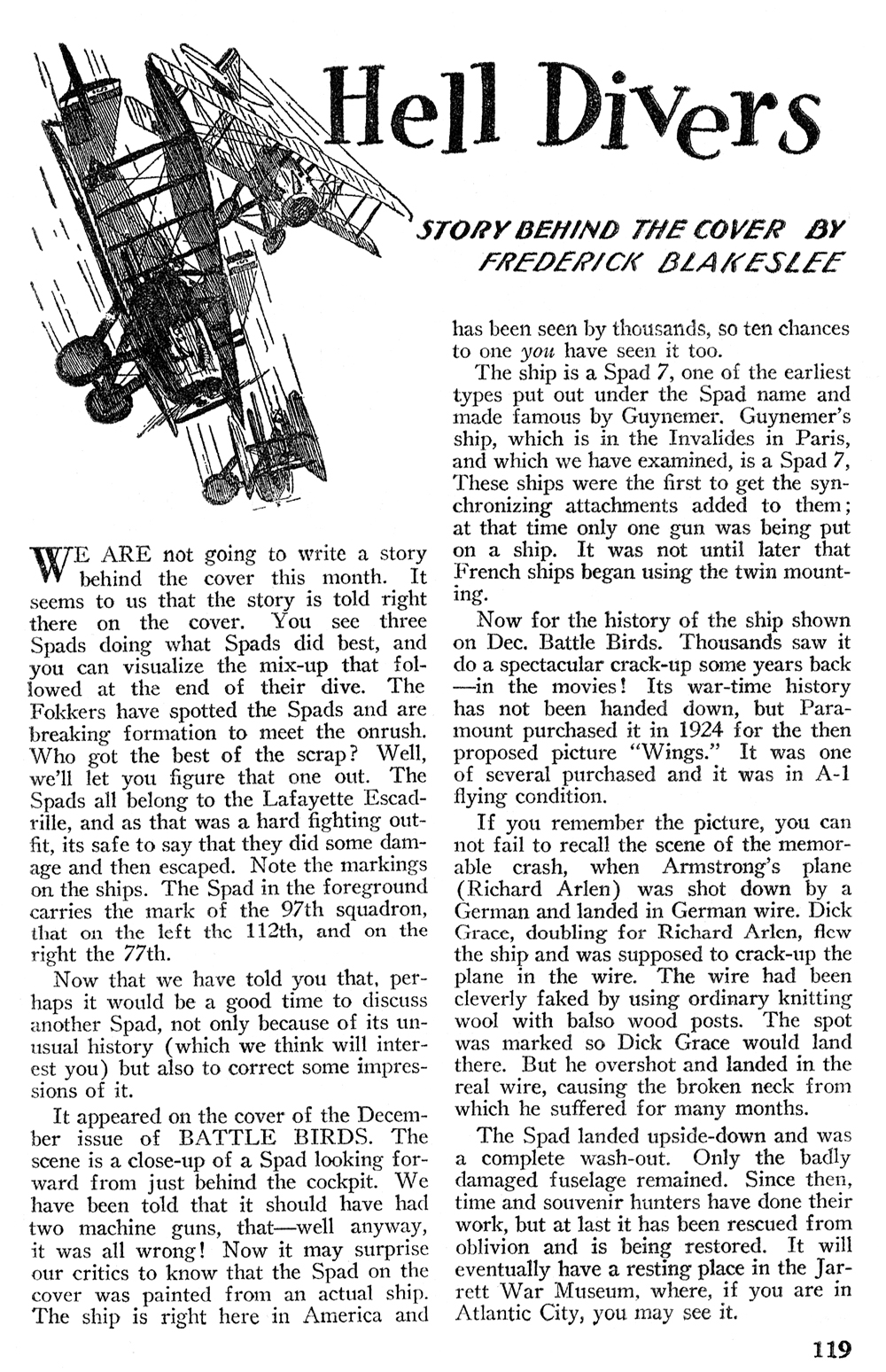“Hell Divers” by Frederick Blakeslee
Frederick Blakeslee painted all the covers for the entire run of Dare-Devil Aces. And each of those covers had a story behind it. This time the story is self evident Blakeslee tells us, but then turns around to tell us the story behind his cover for the prvious December’s issue of Battle Birds and ties our old pal, French Ace Georges Guynemer. All this in February’s cover form 1934—”Hell Divers!”
 WE ARE not going to write a story behind the cover this month. It seems to us that the story is told right there on the cover. You see three Spads doing what Spads did best, and you can visualize the mix-up that followed at the end of their dive. The Fokkers have spotted the Spads and are breaking formation to meet the onrush. Who got the best of the scrap? Well, we’ll let you figure that one out. The Spads all belong to the Lafayette Escadrille, and as that was a hard fighting outfit, its safe to say that they did some damage and then escaped. Note the markings on the ships. The Spad in the foreground carries the mark of the 97th squadron, that on the left the 112th, and on the right the 77th.
WE ARE not going to write a story behind the cover this month. It seems to us that the story is told right there on the cover. You see three Spads doing what Spads did best, and you can visualize the mix-up that followed at the end of their dive. The Fokkers have spotted the Spads and are breaking formation to meet the onrush. Who got the best of the scrap? Well, we’ll let you figure that one out. The Spads all belong to the Lafayette Escadrille, and as that was a hard fighting outfit, its safe to say that they did some damage and then escaped. Note the markings on the ships. The Spad in the foreground carries the mark of the 97th squadron, that on the left the 112th, and on the right the 77th.
Now that we have told you that, perhaps it would be a good time to discuss another Spad, not only because of its unusual history (which we think will interest you) but also to correct some impressions of it.
 It appeared on the cover of the December issue of BATTLE BIRDS. The scene is a close-up of a Spad looking forward from just behind the cockpit. We have been told that it should have had two machine guns, that—well anyway, it was all wrong! Now it may surprise our critics to know that the Spad on the cover was painted from an actual ship. The ship is right here in America and has been seen by thousands, so ten chances to one you have seen it too.
It appeared on the cover of the December issue of BATTLE BIRDS. The scene is a close-up of a Spad looking forward from just behind the cockpit. We have been told that it should have had two machine guns, that—well anyway, it was all wrong! Now it may surprise our critics to know that the Spad on the cover was painted from an actual ship. The ship is right here in America and has been seen by thousands, so ten chances to one you have seen it too.
The ship is a Spad 7, one of the earliest types put out under the Spad name and made famous by Guynemer. Guynemer’s ship, which is in the Invalides in Paris, and which we have examined, is a Spad 7, These ships were the first to get the synchronizing attachments added to them; at that time only one gun was being put on a ship. It was not until later that French ships began using the twin mounting.
Now for the history of the ship shown on Dec. Battle Birds. Thousands saw it do a spectacular crack-up some years back—in the movies! Its war-time history has not been handed down, but Paramount purchased it in 1924 for the then proposed picture “Wings.” It was one of several purchased and it was in A-l flying condition.
If you remember the picture, you can not fail to recall the scene of the memorable crash, when Armstrong’s plane (Richard Arlen) was shot down by a German and landed in German wire. Dick Grace, doubling for Richard Arlcn, flew the ship and was supposed to crack-up the plane in the wire. The wire had been cleverly faked by using ordinary knitting wool with balsa wood posts. The spot was marked so Dick Grace would land there. But he overshot and landed in the real wire, causing the broken neck from which he suffered for many months.
The Spad landed upside-down and was a complete wash-out. Only the badly damaged fuselage remained. Since then, time and souvenir hunters have done their work, but at last it has been rescued from oblivion and is being restored. It will eventually have a resting place in the Jarrett War Museum, where, if you are in Atlantic City, you may see it.

“Hell Divers: The Story Behind The Cover” by Frederick M. Blakeslee (February 1934)
Check back again. We will be presenting more of Blakeslee’s Stories behind his cover illustrations.




